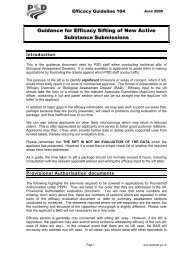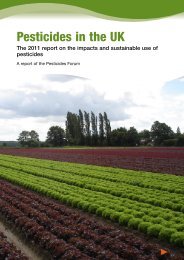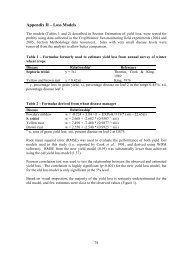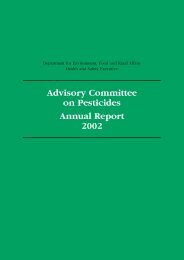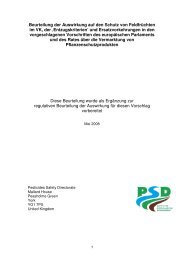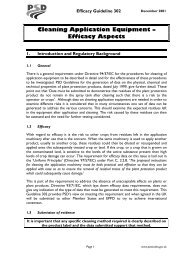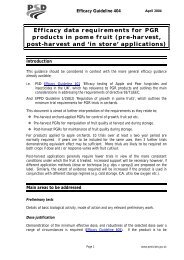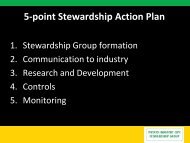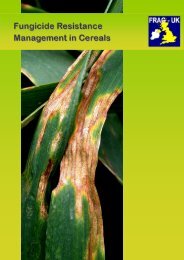Advisory Committee on Pesticides Annual Report 2001
ACP Annual Report 2001 - Pesticides Safety Directorate
ACP Annual Report 2001 - Pesticides Safety Directorate
Create successful ePaper yourself
Turn your PDF publications into a flip-book with our unique Google optimized e-Paper software.
Secti<strong>on</strong> E: UK Review Programme<br />
The <str<strong>on</strong>g>Committee</str<strong>on</strong>g> agreed that the active substance did not warrant classificati<strong>on</strong><br />
as a sensitiser. It also noted that the dimethoate ADI established in 1993 was<br />
different from the Joint FAO/WHO Meeting <strong>on</strong> Pesticide Residues (JMPR) ADI<br />
and therefore asked that the basis for the ADI be re-examined.<br />
The ACP subsequently rec<strong>on</strong>sidered the ADI for dimethoate. The current ADI<br />
of 0.0008 mg/kg bw/day had been established in 1993, based <strong>on</strong> applying a<br />
100-fold uncertainty factor to the no observed adverse effect level (NOAEL) of<br />
1 ppm (approximately 0.08 mg/kg bw/day) from a rat multigenerati<strong>on</strong> study.<br />
The ACP agreed that the ADI for dimethoate should now be derived by<br />
applying a 100-fold assessment factor to the NOAEL of 0.2 mg/kg bw/day in a<br />
human volunteer study. Therefore, an ADI of 0.002 mg/kg bw for dimethoate<br />
was agreed. This new ADI would be used when the strategy for reducing<br />
c<strong>on</strong>sumer exposure was c<strong>on</strong>sidered by ACP.<br />
Malathi<strong>on</strong><br />
Malathi<strong>on</strong> is an organophosphorus insecticide, formulated as an emulsifiable<br />
c<strong>on</strong>centrate, approved for use <strong>on</strong> agricultural/horticultural crops and in pige<strong>on</strong><br />
lofts. This review formed part of the routine UK review programme of<br />
anticholinesterase compounds.<br />
47<br />
The ACP agreed a repeat exposure systemic acceptable operator exposure<br />
level (AOEL) of 0.2 mg/kg bodyweight (bw)/day based <strong>on</strong> the lowest no<br />
observed adverse effect level (NOAEL) in an 18-m<strong>on</strong>th mouse <strong>on</strong>cogenicity<br />
study. The NOAEL of 100ppm (equivalent to approximately 17 mg/kg bw/day)<br />
was based <strong>on</strong> statistically significant red blood cell (RBC) cholinesterase<br />
depressi<strong>on</strong> in females at the 9- and 18-m<strong>on</strong>th interval, at a dose of 800ppm.<br />
This end point was also used as the basis for setting an acceptable daily<br />
intake (ADI) of 0.2 mg/kg bw/day. For these reference values, a 100-fold<br />
assessment factor was used. In additi<strong>on</strong>, the <str<strong>on</strong>g>Committee</str<strong>on</strong>g> agreed that it was<br />
relevant to set a single exposure systemic AOEL of 1.5 mg/kg bw based <strong>on</strong> an<br />
absence of observed effects at the top dose tested of 15 mg/kg bw/day in a<br />
human volunteer study. This-end point was also used as the basis for setting<br />
an acute reference dose (ARfD). For these reference values, a 10-fold<br />
assessment factor was used.<br />
The ACP noted that <strong>on</strong>going mutagenicity studies would require completi<strong>on</strong><br />
before a c<strong>on</strong>clusi<strong>on</strong> could be reached <strong>on</strong> the genotoxicity of malathi<strong>on</strong>.<br />
With regard to operator exposure, the <str<strong>on</strong>g>Committee</str<strong>on</strong>g> noted that estimated<br />
operator exposure levels were below the repeat exposure systemic AOEL with<br />
use of pers<strong>on</strong>al protective equipment, and were therefore acceptable.




